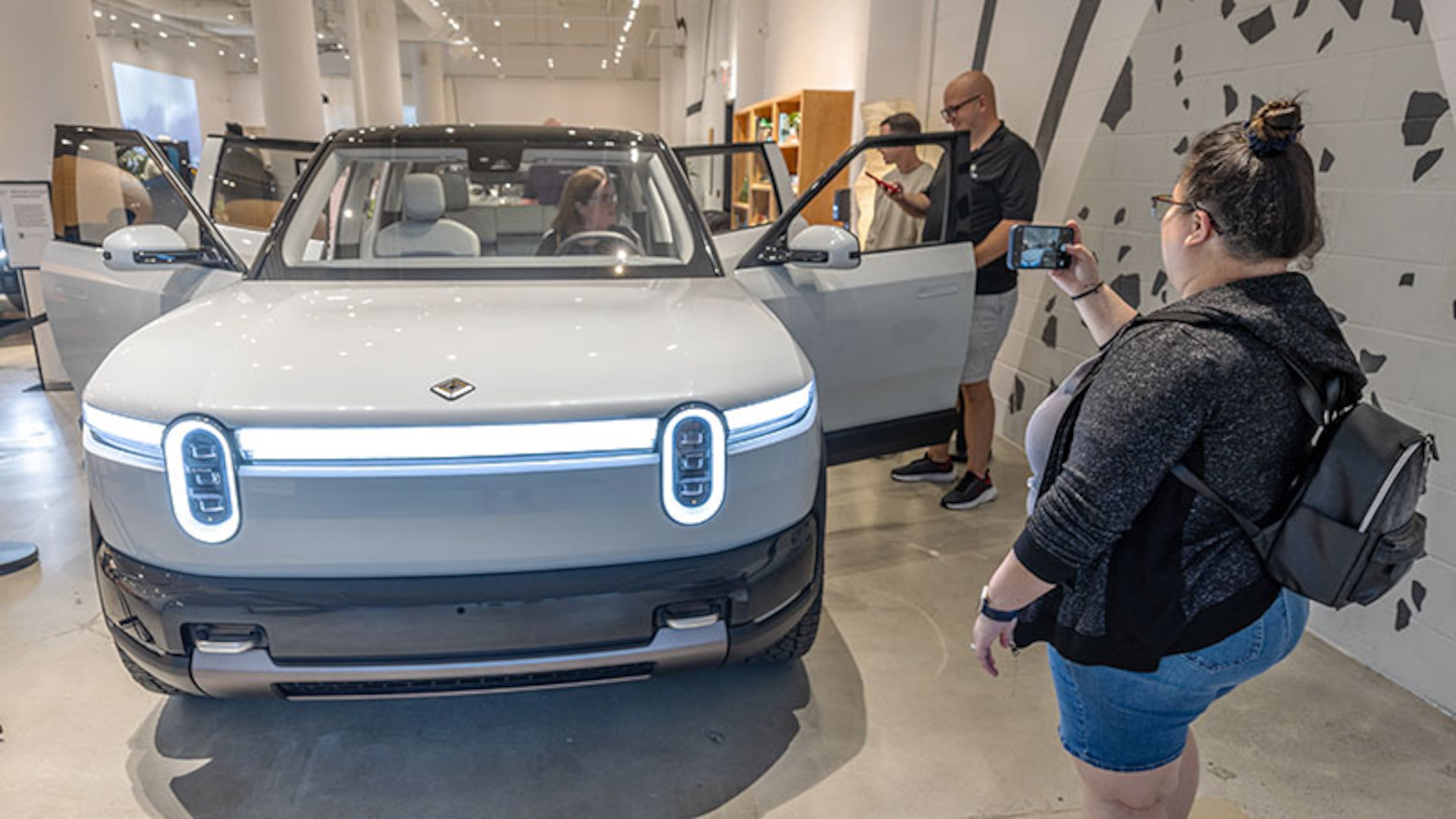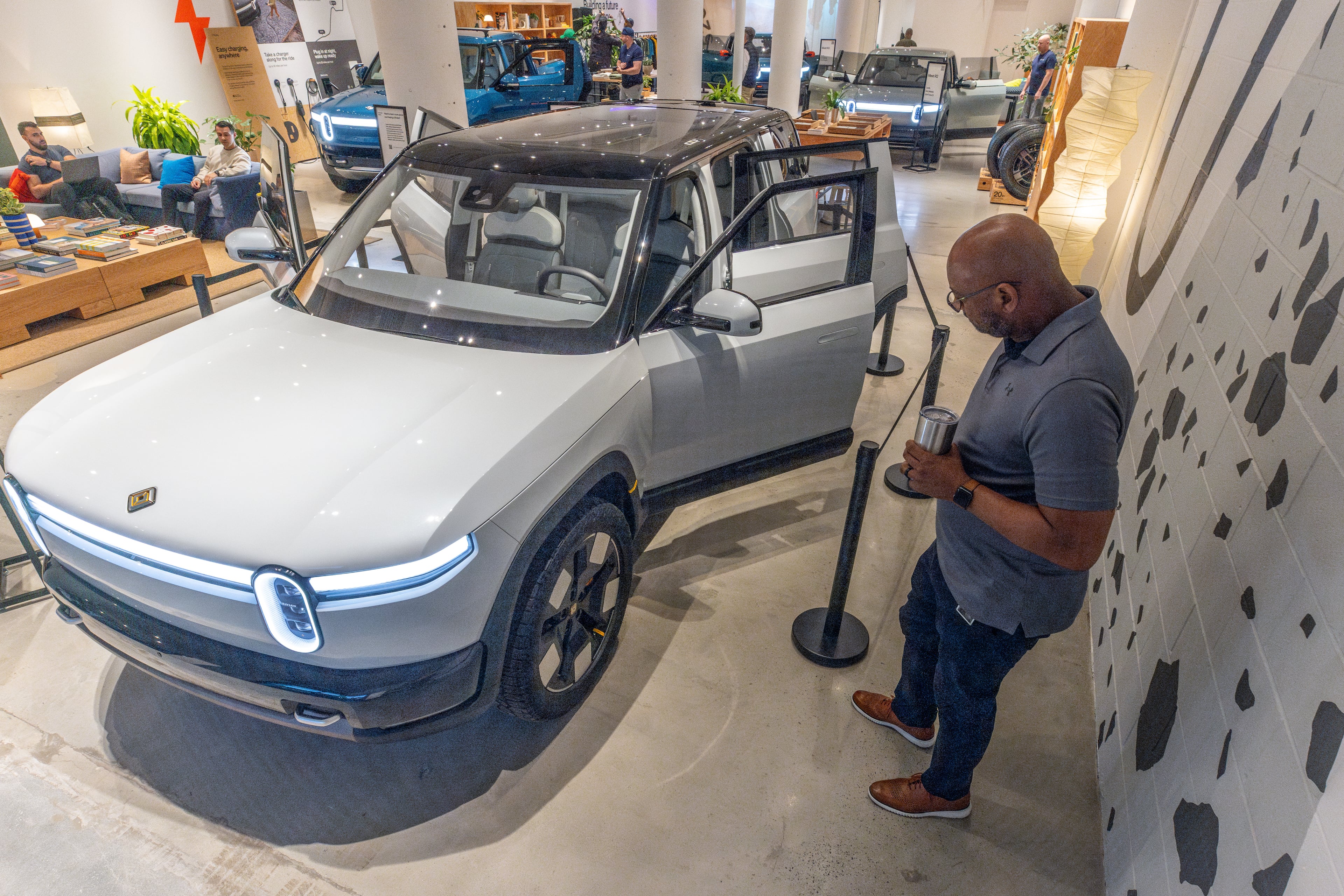The AJC Interview: Rivian CEO RJ Scaringe on the EV maker and its future
RJ Scaringe didn’t build Rivian to make just 50,000 electric vehicles per year.
It’s a company designed to build many times more, the CEO of the upstart EV maker told the editorial board of The Atlanta Journal-Constitution last week. To get there, Rivian is banking on its newest vehicle, the R2, a two-row crossover, to be a big hit.
Initial manufacturing of the R2 will start in Illinois, but Scaringe said production will expand to its future factory an hour east of Atlanta when it opens, albeit years later than initially expected, in 2028. Future models, including the smaller R3 and R3X, are expected to follow.
“The more people that experience an EV, it’s like a one-way door,” Scaringe said. “It’s hard to go into an EV and then back to a (gas-powered) vehicle.”
He said Rivian will start customer deliveries of R2 early next year, and soon start vertical construction of the Georgia plant after a ceremonial groundbreaking in September. In a wide-ranging interview with the AJC, Scaringe went into detail about the company’s future, why Georgia is crucial to that success and the future of the auto industry.
Scaringe likes to say that software is as important to modern cars as the nuts and bolts of assembly.
Rivian is designed to do both. That strategy entranced investors while creating its own challenges and setbacks when the pandemic struck, but Scaringe argues it’s a framework made to support more than just a niche automaker.
The need to ramp up production is why Georgia is such a critical cog in Rivian’s machine aimed at rivaling Tesla as a leader of America’s new school of automaking.
“This is an investment you don’t make for one product cycle,” Scaringe said of his company’s planned $5 billion factory an hour east of Atlanta. “You make the investment for many product cycles. It’s a multidecade, multi-billion dollar investment.”
Next year is a vital one for California-based Rivian, which plans to launch R2 at a starting price of $45,000 to target a mass market. The forthcoming Georgia plant is poised to multiply the number of R2s rolling off assembly lines.

Confident it will succeed, Scaringe said the R2 and its iterations will provide the same boost to Rivian that Tesla found with its mid-priced Model 3 sedan and Model Y crossover.
Those two Tesla models make up more than 40% of all EV sales this year through September, according to Cox Automotive data. Cox Enterprises, the owner of the AJC, also owns Cox Automotive and a 3% stake in Rivian.
“In something like clothing or cars or goods that reflect your own personality, you tend to see many winners,” Scaringe said. “So having a single player with nearly 50% market share is not a reflection of a healthy market — it’s a reflection of a highly underserved market.”
September was a new high-water mark for EV sales, but it’s expected to be a temporary peak. Federal tax credits worth up to $7,500 for qualifying new EV purchases were revoked at the end of that month, creating a fleeting window of opportunity for the EV curious.
“The training wheels are coming off,” said Stephanie Valdez-Streaty, director of operations management at Cox Automotive. “This shift will test whether the electric vehicle market is mature enough to thrive on its own fundamentals or still needs support to expand further.”
For Rivian, Scaringe said the startup’s history until now has been about learning and growing. He said Rivian’s Georgia investments will show the company is ready for the expanded spotlight.
“We’re a much, much more mature business,” he said. “And we’ve built processes to handle some of these unexpected externalities.”
Learning curve
The path for Rivian hasn’t been smooth.
The company’s 2021 initial public offering was among the largest in U.S. history. The company’s valuation peaked at more than $100 billion, briefly surpassing juggernauts like Ford, an early Rivian investor, and General Motors.
Rivian also courted other deep-pocked investors including Amazon, inking a $1 billion deal to supply the e-commerce giant with 100,000 EV vans.
But Wall Street’s stratospheric expectations soon came back to Earth amid the COVID-19 pandemic, a supply chain that buckled under the pressure and Rivian’s struggles to meet production demands. Scaringe said it was a tough time for his company, which has yet to turn a profit.
Among the challenges Rivian faced were getting components because it didn’t have the deep manufacturing history of traditional automakers.
“It was a combination of learning for the first time, launching multiple products, dealing with a global pandemic and then being last in line to get parts from suppliers,” he said.

Those scars have informed Rivian’s R2 strategy, reframing Georgia’s role in the company’s long-term plans.
When unveiling the prototype R2 in March 2024, Scaringe sent shock waves through the Peach State by pausing the Georgia plant’s development. The decision was cited as a temporary cost-cutting measure and an effort to focus on launching R2 more quickly from the company’s existing Illinois factory.
Within 24 hours of the R2 reveal, Rivian announced it had nearly 70,000 preorders. Scaringe declined to provide any updates to that figure but said “the excitement hasn’t waned.”
Rivian later announced it would resume construction of the Georgia factory in 2026, and will create 7,000 promised jobs.
State and local leaders also provided an estimated $1.5 billion incentive package to recruit Rivian to Georgia. Most of those benefits materialize only if the company meets its job and investment figures by 2030. Rivian will also receive support from a $6.6 billion federal loan.
In recent days, Rivian opened its East Coast headquarters along the Atlanta Beltline, which the company said will employ 500 workers by the end of next year. The back-end research and development work, Scaringe said, is just as vital to Rivian’s success as its mechanical chops.
“We didn’t design the business to be selling 50,000 cars a year,” he said, citing the company’s current production output. “We have a cost structure, particularly on the R & D side, that was set up to be a much, much bigger business.”
Creating leverage
Unlike traditional automakers, Rivian and electrified peers like Tesla have developed a new technology backbone for their vehicles.
Most conventional cars have more than 100 small computers called electronic control units to handle small tasks.
One ECU handles seat adjustments. Another is in charge of side mirror controls. Yet another is tasked with injecting fuel into the engine. Those ECUs are developed by separate part suppliers and often include a mishmash of operating systems.
“It’s a very, very messy architecture,” Scaringe said. “It’s precisely the opposite of what you’d want to have.”

Rivian, along with Tesla, have a handful of more powerful computers called domain control units that handle several tasks. Scaringe said that decision reduces assembly complexity, saves thousands of dollars on computer chips and will pay off once the company reaches a certain scale.
“We have more computer engineers and software engineers at Rivian than we have mechanical engineers by a pretty significant degree,” he said.
For automakers to succeed in the future, Scaringe said, they will have to have a software backbone like Rivian and Tesla. They’ll get there one of two ways — developing it themselves or finding a technology partner.
The company’s technology platform caught the attention of the world’s second-largest automaker, Volkswagen Group.
In June 2024, Rivian and VW announced a joint software partnership worth an estimated $5.8 billion. Rivian agreed to contribute technology to the German auto giant’s fleet of new EVs, while VW’s financial contributions would support Rivian as it ramped up production.
Scaringe said that partnership also gives Rivian newfound leverage when negotiating with suppliers and preparing to launch R2 — both in Illinois and in Georgia.

“(Suppliers) are super excited to work with us because the choice we make in Rivian vehicles is also the choice that goes into Volkswagen vehicles, which is Porsche, Audi, VW, Bentley and a whole host of brands,” Scaringe said. “It’s a complete flip of the nature of that relationship.”
With the groundwork laid — and ground literally about to break east of Atlanta — Scaringe said Rivian’s next chapter is filled with potential.
“Now it’s about execution,” Scaringe said.

